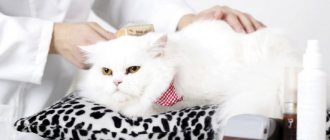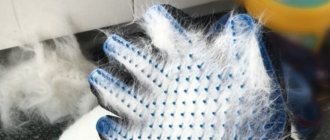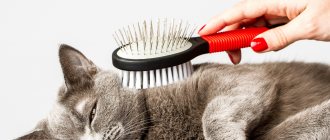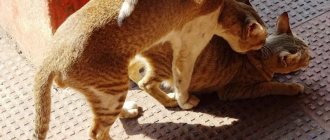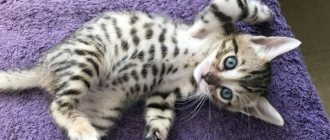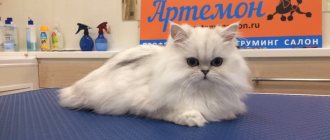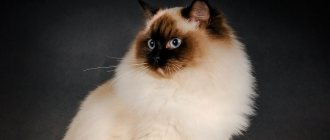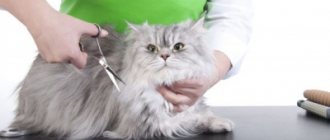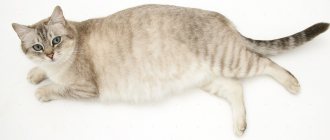Hygienic, high-quality care for pets is called grooming.
The complex of care measures includes combing out excess undercoat, haircut (sometimes shaving), bathing, cleaning the ears and plaque from the teeth, trimming and sealing the tips of the claws. Compared to dogs, cats require less maintenance to keep them hygienically clean. Many veterinarians believe that cats do not need partial or complete hair trimming, since such a procedure can cause more harm than good. And they recommend cutting your pet’s hair only when necessary.
Grooming cats yourself at home
If you don't want to hire a professional, try cutting your cat's hair yourself. But keep in mind that the animal will be stressed and, most likely, will break out. Therefore, you cannot do without an assistant.
Before grooming, trim your cat's claws and then sit her on the table. Have your assistant hold her back legs with one hand and her middle legs with the other and press her to the table. After this, you can start cutting your cat's hair using a clipper. To do this, you need to install a nozzle two to three millimeters long.
It is advisable to cut the cat against the grain, which is more hygienic.
Haircut sequence:
- sides;
- back:
- stomach;
Haircut options
The initial reason why the cat decided to correct the appearance of her fur coat dictates the choice of the type of grooming. According to purpose, cat grooming is divided into the following types:
- hygienic;
- medical;
- artistic (modeling, decorative hairstyles).
Hygienic
This method is used if the animal has accumulated a lot of tangles and they cannot be combed out.
When combing cats no longer saves them from tangles, a hygienic haircut will help rid the animal of clumps of stray hair. Regular trimming of caked fur is not difficult; you can trim a long-haired kitten or an adult cat yourself at home if you have the appropriate tools and minimal skills. The degree of hygienic grooming varies: if there are numerous lumps, cats are cut bald; if the coat is not very matted, problem areas with tangles are simply shaved off.
Model
Unusual fashionable options for the design of fur are made for pets for exhibitions, photo shoots, and just “for fun.” You can choose creative cat haircuts by visiting a pet salon. The traditional model treatment of the Persian and fluffy red cats as a lion is good. Semi-long white kittens are decorated in the style of teddy bears. The white purr is also cut to look like a poodle. Professional artistic grooming of Angora cats, fluffy Persians, British, Scottish and exotic cats should be performed exclusively by a master.
Types of cat haircuts
A hygienic haircut is done no more than 2 times a year, so as not to harm the structure of the coat and skin. If a cat will participate in an exhibition, the last trimming is done no later than six months before the event. The haircut is usually done with a clipper, leaving a hair length of about 3 mm. After this procedure, the animal’s skin becomes “plush” to the touch. It is not recommended to trim your cat on your own; it is better to contact a specialist, a pet beauty salon: for high-quality trimming you need special tools - various types of hairdressing and thinning scissors, a clipper, a set of combs.
You can't cut cats completely bald! This will disrupt the heat exchange process and may cause skin irritation. When trimming a cat, at least a small part of the fur must remain to protect it from sunlight and cold.
Do cats need to be trimmed and how often can this be done?
By providing proper care for pets, we can save them from the upcoming grooming procedure. If they still have a thick, shiny coat and their skin is healthy and elastic, then grooming will become unnecessary.
Kittens need to be accustomed to all manipulations from childhood. They should respond calmly to a comb and brush. It is recommended to brush daily. Besides being necessary, this is a useful and enjoyable massage.
But, if the fur often rolls into tangles, then experts advise cutting it as rarely as possible. Whether cats are clipped with clippers or scissors does not matter. Only a machine haircut will look more impressive and aesthetically pleasing.
As a last resort, you can cut your cat's hair for the summer, but in winter you should refrain. The frequency of haircuts is from one to three times a year.
From all of the above, we can conclude that grooming cats is not necessary. If there is no reason, it becomes a tribute to fashion. Don't forget about the consequences of meaningless haircuts and the stress our pets experience. Often cats become sad after they have been clipped, shiver from the cold and treat their feeder without the former enthusiasm and trust.
In what cases can you not do without a haircut?
Most owners have their own opinion about the indications for grooming a cat:
- getting rid of fur on furniture and carpets during seasonal shedding;
- allergies in the owner and family members (a shorn animal has less fluff, which causes an allergic reaction);
- prevention of overheating (in the summer, cats are hot due to their thick fur coat);
- solving problems with hair (it is easier to remove fleas, ticks, burrs).
Owning a representative of a long-haired breed while suffering from allergies, helping a pet in the heat, solving the problem of seasonal shedding - experts treat such wishes with irony. These are the whims of the owners, and not a real need. Professionals allow haircuts only in two cases:
- To get rid of large tangles. Matted fur causes pain and itching, and involuntary scratching of problem areas. When there is a massive accumulation of them, the cat is cut to relieve discomfort and prevent the development of dermatological diseases.
- As part of preoperative preparation. Before surgical interventions, the animal is not only cut short, but also shaved.
A cat’s beautiful hairstyle pleases its owners, not the cat itself. An incorrectly trimmed tail can even cause your pet to try to chew it off.
Motives and reasons for haircuts
There is a lot of controversy about this procedure. Some people believe that cats should be cut once or twice a year. Others say, on the contrary, that there is no need to trim the animal. Let's look at the pros and cons. First, let's find out whether cats can be cut. The main reasons for shortening the coat are:
- Haircut as a type of hygienic care. This applies mainly to long-haired breeds. During the autumn-spring molting period, the fur rolls into tangles, causing pain and discomfort to our pet. The skin stops breathing and diaper rash appears. Inflammation occurs, resulting in microbes and fungal infection.
- The second reason is considered to be licking and swallowing large amounts of fur, causing vomiting. In the best case, the cat will vomit it; in the worst case, a lump will form, which will lead to digestive problems and intestinal obstruction. The consequence will be a visit to a veterinarian and, possibly, surgical intervention.
- The age of a cat that cannot take good care of its fur, causing it to become dull and matted.
- The shedding period becomes not only a problem for the pet, but also for the owner. Wool appears everywhere: on furniture, clothing, carpets. Even regular brushing doesn't help.
- To prepare for the exhibition, purebred cats are given model haircuts. They must comply with rules requiring strict shapes and hairstyle parameters.
- During skin diseases, the cat needs to be cut and get rid of the hair covering the affected areas. The cause may be lichen, dandruff, mycoses. Treatment with ointments and solutions will be required.
- If a cat is allowed to walk outside, it can become a target for fleas and ticks, which will be difficult to detect on a furry animal.
- Presence of allergic diseases in family members.
From the presented list it is clear that in certain cases, grooming a cat is not a whim of the owner, but a necessity caused by external circumstances. However, there are obvious contraindications to this action.
Why cut your cat's hair?
Cats have a natural need to constantly care for their fur coat. But very often this is not enough, especially for fluffies with a fur length of more than 3 cm. Special care is recommended for such pets, including regular combing, removing tangles and trimming excess hair.
Cat trimming procedure
- It is necessary to fix the pet in a position lying on its side, holding it by the hind and front legs.
- First of all, the tangles are cut off with scissors. After this, they continue cutting the hair on the sides of the body and back using a clipper.
- When trimming fur from the belly, you should carefully avoid the nipples and intimate areas. Experts recommend first cutting the hair in intimate areas with scissors and then completing the manipulation with a clipper. It must be remembered that cats' skin is very thin and easily injured. Therefore, while working with the machine, you need to tighten it so that skin folds do not get under the blades.
- At the end of the procedure, the cover on the paws is cut off.
- The hair on the animal's head is not trimmed; it is possible to shape it with thinning scissors. It is strictly forbidden to trim the mustache, as it is an important organ of touch.
- Tail trimming is carried out at the request of the owner.
If you can’t cut your cat’s hair in one procedure, you can divide it into several stages. This will allow the pet to avoid unnecessary stress, and the master from bites and scratches.
After grooming, the animal must be bathed and dried with a hairdryer. If your cat is afraid, you can remove cut and stuck hairs by wiping it with a damp cloth or chamois cloth. During the cold season, you should create a comfortable microclimate without drafts in the room where the pet is.
How to trim or shave a pet?
There is nothing complicated in grooming a cat if you follow the rules and sequence of actions:
- Nail trimming. The claws are trimmed with special tweezers, having been disinfected in advance. When you lightly press the paw pads, the hidden claws will extend. The owner will need to trim only the very ends.
- To begin with, you may need an assistant - he will hold the animal, preventing it from running away. Some cats react aggressively to the appearance of grooming tools. For the safety of the owner and the pet itself, it is worth putting a special plastic collar on the animal that does not allow it to bite.
The cat is laid on its side, its paws are fixed. To cut, you need a machine or scissors. The machine will help avoid damage to the skin, but can be frightening with its buzzing.- First, the hair is removed from the sides, and then moved to the back and belly. You need to remove hair as it grows, and in the opposite direction. Hair that remains long after cutting with a clipper can be trimmed with nail scissors. There must be a tassel on the tail.
- At the end of the procedure, the pet must be bathed with a special shampoo for cats, and then dried with a towel. If your pet is not afraid of a hair dryer, it can also be used for drying. But veterinarians still recommend going to a professional groomer. Because he is a competent and qualified specialist. He will do the haircut quickly and without any damage.
When performing a haircut of any shape, there are certain rules:
- in order not to damage the mustache and hair in the ears, the hair on the head, muzzle and in the auricle is not cut;
- “socks” are left on the lower part of the legs;
- the hairs of the front legs under the elbow and from the hind legs under the jumping joint are not removed;
- the hair is left at the end of the tail (a section at least 3 cm long must be left uncut).
Why do you need a haircut?
Owners of furry pets have different opinions on this issue. Some are categorically against such a procedure, because they sincerely believe that the haircut disfigures the cat. And others not only take their pet to the hairdresser, but also maintain a regular schedule. There are several main reasons explaining why cats need a haircut: - Due to the increased body temperature of cats compared to humans, they can easily tolerate hot summer weather, but if the temperature outside exceeds 35-40 degrees, cats begin to feel unwell. If you decide to cut your pet’s hair to make its life easier, follow certain rules, or better yet, consult a specialist. He will calculate the required length of fur that needs to be left for the pet so that he does not become vulnerable to direct sunlight or catch a cold from a draft and air conditioning. — The appearance of bald patches on a pet’s body often frightens owners and leads to unplanned haircuts. But when the hair grows back, the bald patches remain. In this case, hairdressing services are not able to solve the problem, contact your veterinarian to find the cause and begin timely treatment. — During shedding, caring for a cat takes a lot of time and effort, and cleaning an apartment where fur constantly flies around is not fun. There is an opinion that if you cut an animal's hair, the problem will be resolved. This is a mistake - after growing overgrown, the cat will begin to shed again. If shedding time is delayed, contact your veterinarian. The specialist will find the reason, perhaps it is high humidity in the room, stress in the pet, or improper feeding. — Not all owners find a common language with their pet; cats simply do not allow themselves to be brushed. Thus, tangles form on the animal’s body, which tighten the skin, cause itching, and cause discomfort. A nest for fleas, fungi and various infections is formed under the mat. If your cat has thick, long hair, pay special attention to its care. — Another reason is the cohabitation of a cat and a person with upper respiratory tract diseases and allergies. Grooming cats will help allergy sufferers and asthmatics avoid a trigger (a factor that causes suffocation and exacerbation of the disease). — It happens that the pet is sick or too old. If an animal cannot properly care for its fur, a haircut will also help. - Pets need to be cut to be simply beautiful! This is especially true before exhibitions. A groomer will help you with a model haircut. It can be original, emphasizing the individuality of the pet.
How to trim your cat's hair at home
There are two main reasons why owners refuse the services of professional groomers and learn to trim cats themselves:
- Saving money and time.
- Caring for the psychological state of the pet.
Most cats feel more comfortable and calmer in their familiar home environment and trust more the manipulations that their beloved owner performs with them. For those who are not afraid and are ready to master the art of grooming, here are our useful tips on cat grooming.
What you need to groom a cat
Think about where it will be more convenient for you to groom your pet. Some owners prefer to do this in the bathroom to make it easier to clean up the cut wool. If you choose to mow in a room, remove carpeting from the floors. Make sure there is a flat surface (table) on which you will cut your hair. Place an old towel on the table.
Before you begin the process, purchase:
- medium-sized animal clipping scissors with sharp blades and rounded ends;
- a special machine for grooming cats.
You may also need:
- a sparse comb and brush to comb out the coat before cutting;
- a fine comb - to carefully cut out tangled areas and tangles, placing it between the animal’s skin and the clipper;
- hydrogen peroxide for treating occasional wounds.
Tips for grooming cats at home
- Select the place where the haircut procedure will take place, prepare the work surface.
- Start by trimming the nails - this way you will protect yourself from your pet’s aggression and possible injuries.
- It is more convenient to groom a cat at home with two people - ask one of the household members to help you. Let him hold the cat's sides and limbs while you work.
- If the cat is too aggressive, put an Elizabethan collar on the animal.
- Before you start grooming, talk gently to your pet, offer him a treat or a favorite toy, and gently comb him with your favorite comb.
- Act confidently, but carefully - the cat may feel the owner’s excitement and will become worried.
- The haircut starts from the back and sides. After this, carefully move to the abdominal area. The limbs and tail are usually left untouched at home.
- The area around the mammary glands is carefully processed with scissors, pulling off the hair and placing a fine-toothed comb.
- If you are using scissors, lightly dampen the wool. Only dry wool can be cut with a clipper.
- If you want to leave longer hair, work in the direction of hair growth. For a shorter haircut, shave against the direction of hair growth.
- During the cutting process, clean the clipper blades from hair.
- After grooming, bathe your pet with a mild detergent and dry the cat dry.
Don't forget to treat your cat with something tasty when you finish the grooming procedure.
Important!
If your cat is not in the mood for a haircut, breaks free and runs away from you, do not chase the poor animal - this is stressful for him! Postpone the haircut and try again in a few days.
Can tools be used to cut a person's hair?
Professional groomers answer this question - absolutely not! Let's explain why. Yes, hairdressing scissors and hair clippers for humans are no different in appearance from the same devices for grooming pets.
But the structure of wool and human hair is very different. Wool is much softer. In addition, cats have an undercoat (downy hair). The blades of human instruments are not designed for this. If a cat owner's clipper is used to groom a pet, it will quickly overheat and the blades will quickly become dull. Dull blades do not cut, but “jerk” – this causes discomfort and pain to the animal.
Therefore, if you decide to cut your cat’s hair yourself, do not spare money and do not torture your pet - purchase special devices for grooming animals.
Important!
The only thing you can use a regular clipper for is to remove a single mat from a short-haired cat.
Video:
Cons: unpleasant consequences of a haircut
- Grooming, like bathing, is a stressful procedure for a cat. After it, the animal may look sad, depressed, and out of resentment, it may begin to ignore the owner. Particularly proud pets may leave a “surprise” in the owner’s slippers in retaliation for encroaching on their fur coat.
- After cutting, the structure of the hairs of the coat changes: they become somewhat thinner. In addition, the animal's color may become lighter.
- If the hair is cut too short, the cat risks overheating in the sun or catching a cold due to hypothermia under the air conditioner or in a draft. Dryness of the skin and loss of elasticity are also possible.
- In some cases, after a haircut, hair does not grow back on some areas of the skin, that is, alopecia occurs. It is caused by hypothermia and a change in the correct growth of hairs. This pathology usually occurs in dogs, but occasionally occurs in cats. If bald spots began to appear before the haircut, do not try to solve the problem with its help: a veterinarian’s consultation is necessary.
What should you know before grooming your cat?
Before taking your baby to professional stylists, you need to familiarize yourself with several important rules: 1) If the cat is about to have an exhibition, then a haircut can be done no later than 6 months before this event. In addition, show animals cannot be cut bald. 2) The grooming procedure largely depends on the character and temperament of your pet. Anxious cats are often given muscle relaxants for a calm, simple, stress-free grooming experience. 3) Sometimes haircuts cause changes in the color and structure of the fur. However, in practice this happens very rarely. 4) The speed of hair restoration in cats varies from person to person. Some pets cannot regain their original fur length for many months. 5) Professionals are sure that during a haircut you should not touch the hair on the face, head and ears.
Everything you need for a haircut
Of course, to cut a cat's hair, it is better to turn to specialists, but you can do a simple haircut yourself at home. The fur of different cat breeds varies in length, stiffness and density, and each pet will require a different approach. You will need:
- Table (you can use an ironing board);
- Scissors;
- Comb;
- Hair clipper (preferably with veterinary attachment No. 3);
- Hydrogen peroxide or iodine (in case of accidental injury to the pet's skin).
Before you start grooming your cat, be sure to trim its nails.
Features of haircuts and why they are needed
Only at first glance it seems that grooming cats is solely a whim of the owners. In fact, it is essential to keeping your pet in excellent health. Stray hair can cause a cat significant discomfort and even cause severe pain. As a result, the animal will become irritable and nervous, will stop allowing itself to be stroked, and will not seek the attention of its owners. And, of course, a haircut makes the cat more attractive, funny and interesting.
- Why you need to cut your hair - the main reasons
- How often should you cut your pet's hair?
- What should you know before cutting your hair?
- Types of cat haircuts
- Home haircut
- Model haircut
- Is it possible to cut your pet's hair yourself?
How long does it take for fur to grow back?
In general, for most breeds the terms are more or less equal. Cat hair grows more slowly than human hair. Approximately 1-1.5 cm per month. The average period can take up to 6 months. This is the answer to the question of how quickly a cat’s hair grows.
ATTENTION! Of course, one should not exclude individual characteristics, nutrition, hereditary and acquired diseases and other external factors.
Hair reaches a certain height. Then he stops. Gradually it will fall, giving way to new lint. It is important to understand that a total haircut leads to the fact that developing hair is also destroyed. This can cause serious harm to your pet in the long run. But more on that later.
Let's note three main factors that will speed up hair growth:
- Diet. The protein content must be at least 30% of the total dry matter. Pay attention to vitamins, fatty acids and separately zinc. The main products are meat, some sea fish, and egg yolk. Some owners prefer exclusively nutritional supplements.
- Hair care . This is, firstly, regular combing. Secondly, this is a preventative, shallow haircut with a trimmer. And, of course, stress. A meeting with a huge dog or the first bath greatly affects the pet’s psyche. The longer an animal is stressed, the higher the chance of baldness. In this case, the cat may not grow hair at all or partially. For example, on the head or tail.
- Environment . Seasonal molting in cats is a process inherent in genes. Living in city apartments slightly disrupts this process, but the basics remain. During the spring-summer period, a cat grows faster, regardless of the region of Moscow or Yakutsk. In winter, growth slows down to retain as much heat as possible.
Accordingly, cutting in the summer will result in the owner seeing a change in the undercoat faster than in the cold season. There is no practical value in this. The main thing to remember is that cutting a cat’s hair in winter is contraindicated.
What are whiskers needed for, and how does a cat use them?
Why do cats need whiskers? With their mustaches and eyebrows they “feel” the nearby space, receiving additional information about it. Vibrissae allow a small predator to:
- Determine the distance to objects and their size. For example, with their help, a cat, approaching a hole, can correlate its size with the width of its own body and decide whether it should try to get inside.
- Orientate yourself in space even in the dark. By analyzing information from the vibrissae and other sense organs, the brain creates the most complete picture of the surrounding world. In the dark, cats see better than people, but the main helpers in conditions of limited visibility are not their eyes, but their whiskers.
- Get to know something new. To obtain information about an object, another animal or person, the cat approaches it, directing its whiskers forward.
- Determine external conditions (atmospheric pressure, humidity, temperature) and sense their slightest changes. When the cat does this, the whiskers move slightly. It has been noticed that before natural disasters or weather changes, the behavior of animals changes.
- Avoid eye damage. The cat is able to make his way through thorny thickets even in the dark - touching the branches with his whiskers, he automatically closes his eyelids.
- Assess the speed and direction of the wind in order to correctly choose the strength and trajectory of the jump.
- Get information about food. Everything that is near the muzzle does not fall into the animal’s field of vision. The nose and whiskers help the cat determine what is in front of it.
- Monitor the condition of the prey that is in the teeth.
- Determine the structure and temperature of the surface. The vibrissae located on the paws are responsible for this.
Vibrissae are an indicator of the animal's mood. The whiskers are directed forward - it shows interest and is ready for active action. If they are pressed to the face, the cat is scared or aggressive.
Is it possible to shave a cat's head?
Animal wool plays a big role: it protects against hypothermia, sun rays, and protects the skin from accidental damage. Cats that are constantly kept indoors are no less susceptible to injury than street cats.
Shaving the head is strictly prohibited: sensitive vibrissae are located here, damage to which is contraindicated. Hair cutting bald is an extreme measure, permissible if it is impossible to remove building mortars and foam from the coat, and it is also necessary before surgery. In other cases, shaving your pet will not bring any benefit, but can cause the development of colds.
In addition to the above, it is unknown how long the wool will take to recover. This usually happens within six months, but if there is a lack of nutrients, the process can drag on for several years.
Who is doing?
Decoration from animal fur can only be done by an experienced specialist in this matter.
Depending on the purpose of the haircut, it can be performed in different places. A veterinarian will trim the mats. The procedure is common in veterinary clinics, but it is also performed by a cat groomer in a salon. Complex types of artistic hairstyles and work with dense, long and thick fur, cutting Siberian, Norwegian and Persian cats is done only in zoo hairdressers. Decorative haircuts for cats should be performed by a groomer; it is better not to try to cut your pet’s hair artistically on your own - the cost of a mistake is too high.
Animals cannot be groomed with a regular human machine. It is permissible for people to trim a cat using hairdressing equipment in an emergency and provided that the trimmer has at least 30 watts of power and the blades are ultra-sharp.
Necessary accessories and preparation for a haircut
If, nevertheless, there is an urgent need to groom a cat, but the owner is afraid of injuring the pet and is not sure that he can cope with the procedure, you can contact grooming specialists in a professional salon. This operation is also included in the price list of many veterinary clinics.
In case of self-grooming at home, the animal owner must first purchase the necessary tools and equipment and perform certain actions:
- Prepare a table or wide ironing board as a grooming area.
- Buy large and small scissors with rounded tips and sharp blades made of high-quality steel, a furminator.
- Choose and buy a trimmer - a special machine for cutting animals. The optimal nozzle for cats is usually 3 mm. The device cannot be used on human hair, as cats have a completely different hair structure. You also need to decide on the power of the device, so for Persians it needs high (45-60 W), for semi-long-haired pets you can limit yourself to 20 W.
- Make sure there is minimal stress for the cat. Thus, more powerful rotary trimmers make a lot of noise and frighten the animal; it is worth choosing a model with a mains adapter and a vibration-type motor.
- The cat may need to be given sedatives the day before the procedure. It should be remembered that synthetic substances and anesthesia will harm your pet; it is better to use herbal products.
- Sometimes it is advisable to use an Elizabethan collar - a special device worn around the animal’s neck. It can prevent a nervous cat from biting and injuring the groomer. A special muzzle can also help - a cap that covers the cat’s mouth and eyes.
- Most likely, you will need a special machine for cutting hair on the paw pads, face, around the genitals, and in other hard-to-reach places.
- It is necessary to provide thinning scissors and a massage brush to bring the hairstyle to its final shine. Also, for some (especially short-haired breeds) cats, you will need velvet for polishing, wet wipes to remove excess hair, or a special glove.
- It is also worth making sure that you have on hand the means to provide first aid to your pet if an accidental injury to the skin occurs. It is better not to use alcohol-containing compounds (iodine), but to purchase hydrogen peroxide, Miramistin, Chlorhexidine, and special talc.
You should invite another person as an assistant, and the pet itself should have its claws trimmed at least 24 hours in advance.
Prices for haircuts for cats in grooming salons in Ukraine and Russia
Russia (current prices in Moscow and St. Petersburg)
- Hygienic haircut – 1000-1500 rubles;
- Model haircut – from 1500 to 2500 rubles;
- Cutting patterns - the price is negotiated individually;
- Grooming at home - included in the cost of a haircut or plus 500 rubles;
- Additional payment for the aggressiveness of the animal - 500-1200 rubles.
- Haircut using anesthesia - from 1900 rubles.
Ukraine (how much does grooming cost in Kyiv)
- Hygienic cat grooming – from 200 hryvnia;
- Model haircut – from 300 hryvnia;
- Fantasy haircut, cutting of patterns - the price is negotiated separately depending on the complexity of the pattern;
- Grooming at home – 300 hryvnia;
- Haircut with anesthesia in the salon and at home – 350 hryvnia;
- Additional payment for cat aggressiveness is 50% of the cost of services.
Why you can't cut cats
Now let's look at the reasons why it is undesirable to cut cats:
It is not recommended to cut your hair bald during the off-season when there is no heating at home. This usually causes discomfort and hypothermia in the animal. You should not cut short-haired cats or cats. Wool protects the skin from dryness. Cases have been recorded when it stops growing in some places after grooming. If there is an air conditioner or fan in the house, the cat may catch a cold or get a skin burn in the sun. If your pet has smooth, well-groomed fur, there is no need for a haircut. After it, the structure of the hair changes, it becomes much thinner. You cannot cut cats of semi-longhaired breeds. Their fur performs the function of maintaining thermal balance, saving them from overheating and cooling. These include Norwegian Forest, Siberian, and Maine Coons. With careful care of the coat, systematic combing and bathing in a special shampoo and conditioner, it will be possible to keep it in excellent shape.
It is important to use special feed. In some breeds, frequent haircuts cause color changes.
You should also not trim the hair on the animal’s head or the tip of its tail. If the tail is completely bare, the cat will chew it and may injure it with its teeth.
Why shouldn't you cut cats?
Cats do not need a haircut: their fur creates a protective function, regulating body temperature and saving the paw pads from various injuries. These animals “wash themselves” by licking themselves and their relatives; combing itself with claws, thereby preventing the formation of tangles.
If the owner believes that his pet is suffering from the summer heat, then there is no need to rush into cutting it. It is enough to provide the cat with a cool place, for example in the bathroom, under an air conditioner, and you should also make sure that there are several bowls of water in the house.
How is cat grooming done?
For a “hygienic” haircut, professional clippers are used; an ordinary clipper is not suitable for such purposes. The hair after such a haircut remains on the cat's head, the middle or tip of the paws and at the end of the tail. The cat clipper has special attachments that allow you to adjust the length of the hair being cut. If cats are groomed to remove tangles and excess hair, use attachment No. 3, which leaves a hair length of 0.3 mm.
This length is considered optimal - the wool will not prick and cause skin irritation, plus it will be pleasant to the touch.
Sometimes, with skin diseases, it is necessary to make the hair even shorter, then you will need attachments No. 2 and No. 1 - they cut very short.
A model haircut is also done with a machine, using the same nozzle No. 3, but using special “thinning” and other hairdressing scissors. The most famous of the model cat haircuts is “Lion”. The good thing about a lion haircut is that it is a combination of a hygienic and fashionable haircut; it removes tangles and helps fight overheating; in addition, the cat takes on a completely different, unusual and interesting look.
Usually cats are groomed together, the hairdresser works with a clipper, and his assistant holds the cat on the table by the hind and front legs, this is how cats are groomed without anesthesia. Unfortunately, not all cats like the process of grooming and the noise the clipper makes. In advanced cases, cutting hair from tangles can be very unpleasant; the cat may resist strongly - so it is safer to use a mild sleeping pill to avoid cuts and stress.
Professional grooming: types
Home grooming is practiced by all loving and responsible animal owners. A professional approach allows you to choose the right hair care products and determine the set of necessary procedures. Professional grooming includes the following types:
All types of grooming have their own characteristics and characteristics. All pets need hygiene procedures at any time of the year. Aesthetic manipulations give pets a well-groomed appearance and emphasize the pet’s individuality. Exhibition grooming is a necessary procedure when preparing animals for competitions and exhibitions.
Hygienic grooming
Hygienic care involves combing the coat, disinfectant bathing, treating wounds, and trimming nails. Other hygiene procedures include:
- drying and styling wool;
- thorough brushing of teeth;
- removal of ticks;
- ear examination;
- hair cutting.
The health and appearance of the pet depends on hygiene procedures. Based on the condition of the dog or cat's skin, the groomer can notice the disease at the initial stage. In the absence of regular care, the skin is susceptible to fungal diseases, and matted hair causes inconvenience to the animal.
Decorative grooming
Aesthetic grooming is not much different from procedures in ordinary beauty salons. These types of grooming are more suitable for pets participating in thematic competitions and exhibitions. Aesthetic manipulations include a range of works:
- professional wool decoration;
- teeth whitening;
- hair cutting, wool dyeing;
- body art;
- wool styling;
- pedicure.
Decorative grooming may include the following procedures: tinting the coat, cutting beautiful patterns, using bows, hairpins and other accessories. Piercing is a new procedure, but it is not suitable for all animals. Ear piercings can cause injury to your pet if the jewelry gets caught on an object. One interesting procedure is the top note hairstyle, which is suitable for long-haired breeds. This hairstyle not only performs a decorative function, but also protects the eyes of animals from getting hair. A properly done hairstyle emphasizes the characteristics of a particular breed.
Exhibition grooming
When preparing for exhibitions, animals will need special procedures. The set of procedures depends on the breed of dog or cat. Experienced groomers will fulfill all the requirements for a particular breed. Bathing and brushing are just the beginning of preparing your pet for a show. A lot of time is spent on hair styling, show haircuts, pedicures, and dental sanitation. Grooming and other procedures are performed in accordance with established breed standards. People who are just looking to adopt dogs or cats may not know what show grooming is. The best cosmetics are used to care for the hair of exhibitors. You can visit such an exhibition to purchase high quality products.
